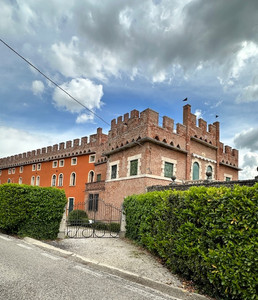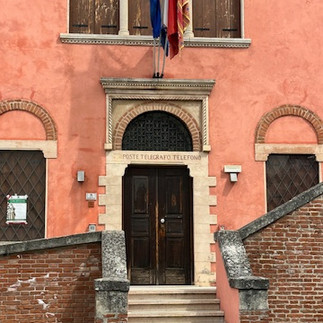Creazzo Vicenza
- Maria Scuor
- Apr 23, 2024
- 5 min read
Italiano in ogni sezione
Here is a TikTok video at the top of Creazzo hill - Ecco un video TikTok in cima alla collina di Creazzo
While we were in Vicenza, we took a side trip to visit Renato and Doloris in Creazzo. We had coffee and one of the flakiest and creamiest brioches I’ve had in Italy at Pasticceria Elisir. From there we stopped for a visit at their home and then we travelled up the hills of Creazzo. Most of the population of Creazzo lives in the plains but many live on the hills.
The hills are renowned for the production of fiolaro broccoli in the winter and small tasty figs called figarolo in the summer. After the Lombard domination, around the year 1000, floods and Hungarian invasions pushed the population up to the hilly areas, where “old town” was built around the castle of the bishop of Vicenza. By 1130 the fortress was destroyed and rebuilt but it, as well as the rest of the village were set on fire in 1313.
It wasn’t until the 15th century that The Scola Camerini Castle was built, then renovated in the 17th and 19th century. After the 15th century, the lands of Creazzo hills attracted land owners of nearby Vicenza. This is when many villas were built and currently exist as residences. The castle is owned privately as a residence and stands on the hill as one of the greatest examples of Vicenza’s eclectic architecture.
Here are photos of the Scola Castle - Ecco alcune foto del Castello di Scola
Mentre eravamo a Vicenza, abbiamo fatto una sfilata per visitare Renato e Doloris a Creazzo. Abbiamo preso un caffè e una delle brioches più friabili e cremose che abbia mai avuto in Italia alla Pasticceria Elisir. Da lì ci siamo fermati per una visita a casa loro e poi abbiamo risalito le colline di Creazzo. La maggior parte della popolazione di Creazzo vive in pianura, ma molti vivono sulle colline.
Le colline sono rinomate per la produzione del broccolo fiolaro in inverno e dei piccoli fichi saporiti chiamati figarolo in estate. Dopo la dominazione longobarda, intorno all'anno 1000, le alluvioni e le invasioni ungheresi spinsero la popolazione fino alle zone collinari, dove sorse il "centro storico" intorno al castello del vescovo di Vicenza. Nel 1130 la fortezza fu distrutta e ricostruita, ma essa, così come il resto del villaggio, fu incendiata nel 1313.
Fu solo nel XV secolo che fu costruito il Castello Scola Camerini, poi ristrutturato nel XVII e XIX secolo. Dopo il XV secolo, le terre delle colline di Creazzo attirarono i proprietari terrieri della vicina Vicenza. Questo è il periodo in cui molte ville sono state costruite e attualmente esistono come residenze. Il castello è di proprietà privata come residenza e si erge sulla collina come uno dei massimi esempi dell'architettura eclettica vicentina
A short winding road took us from 33 to 200 m above sea level and parking is available in Piazza Roma. As soon as we got out the car, we saw this sign that states “By order n. 123/2013, Establishes the prohibition of the game of football in the relevant areas of the Palazzo del colle in Piazza Roma”. Violators can be fined 25 – 500 euros. This is the first time I’ve seen a ban on Italy’s favourite sport.
In Piazza Roma there is a beautiful old building with tower which was approved, built and inaugurated in 1928. It was the municipalities city hall, which originally had a porch but was demolished in the seventies. In 1983 it was approved to build a new building in San Marco area but it wasn’t until 1991 that the building was completed. It now is a building hosting the Italian Post Office.
From this location there are beautiful views of the plains of Creazzo and further in the distance the city of Vicenza.
Here are some photos of the previous city hall, now post office - Ecco alcune foto dell'ex municipio, ora ufficio postale
Here are photos of the views from the hill of Creazzo - Ecco le foto della la vista dalla collina di Creazzo
Una breve strada tortuosa ci ha portato dai 33 ai 200 m sul livello del mare e il parcheggio è disponibile in Piazza Roma. Appena scesi dall'auto, abbiamo visto questo cartello che recita "Con ordinanza n. 123/2013, Stabilisce il divieto del gioco del calcio nelle aree di pertinenza del Palazzo del colle in Piazza Roma". I trasgressori possono essere multati da 25 a 500 euro. Questa è la prima volta che vedo un divieto per lo sport preferito in Italia.
In Piazza Roma c'è un bel palazzo antico con torre che è stato approvato, costruito e inaugurato nel 1928. Era il municipio del comune, che in origine aveva un portico ma è stato demolito negli anni Settanta. Nel 1983 è stata approvata la costruzione di un nuovo edificio in zona San Marco, ma è stato solo nel 1991 che l'edificio è stato completato. Oggi è un edificio che ospita le Poste Italiane.
Da questa posizione si gode di una splendida vista sulla piana di Creazzo e più in lontananza sulla città di Vicenza.
Across the way is San Ulderico Parish dedicated to Saint Ulrich who was a monk that became the bishop of Augsburg and venerated as a saint by the Catholic church. It was built around 990 and enlarged in the 15th century then rebuilt in 1630. In 1832 the original bell tower collapsed and was rebuilt away from the church. In 1842 the church was reconsecrated. Recently it was restored and decorated.
Next to the bell tower is “Parco della Remembranze”. It is a memorial park dedicated to the fallen soldiers of the First and Second World War. This location was the Creazzo cemetery from 1808 – 1894 and in 1914 was moved to Rivella area. In 1922, the park was approved and in 1923 the memorial statue was moved to the location and inaugurated on April 22, 1993.
Here are photos of Saint Ulderico Church and Parco della Remebranze - Ecco le foto della Chiesa di Sant'Ulderico e la vista Parco della Remebranze
Parco della Remembranze
Dall'altra parte della strada si trova la parrocchia di San Ulderico, dedicata a Sant'Ulrico, un monaco che divenne vescovo di Augusta e venerato come santo dalla chiesa cattolica. Fu costruita intorno al 990 e ampliata nel XV secolo, poi ricostruita nel 1630. Nel 1832 il campanile originario crollò e fu ricostruito lontano dalla chiesa. Nel 1842 la chiesa fu riconsacrata. Recentemente è stato restaurato e decorato.
Accanto al campanile si trova il Parco della Remembranze. Si tratta di un parco commemorativo dedicato ai caduti della Prima e Seconda Guerra Mondiale. Questa sede fu il cimitero di Creazzo dal 1808 al 1894 e nel 1914 fu trasferito in località Rivella. Nel 1922 il parco fu approvato e nel 1923 la statua commemorativa fu spostata nel luogo e inaugurata il 22 aprile 1993.





























































Comments